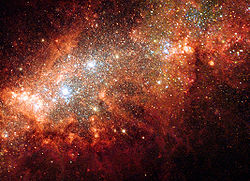| NGC 1569 | |
|---|---|
 A Hubble Space Telescope (HST) image of NGC 1569 | |
| Observation data (J2000 epoch) | |
| Constellation | Camelopardalis |
| Right ascension | 4h 30m 49.1s [1] |
| Declination | +64° 50′ 53″ [1] |
| Redshift | -104 km/s [1] |
| Distance | 10.96 ± 0.65 Mly (3.36 ± 0.20 Mpc [2] ) |
| Apparent magnitude (V) | 11.9 [1] |
| Characteristics | |
| Type | IBm [1] |
| Size | 15,750 ly (4.83 kpc) [1] |
| Apparent size (V) | 3.6′ × 1.8′ [1] |
| Notable features | Contains two super star clusters |
| Other designations | |
| UGC 3056, [1] PGC 15345, [1] VII Zw 016, [1] Arp 210 [1] | |
NGC 1569 is a dwarf irregular galaxy in Camelopardalis. The galaxy is relatively nearby and consequently, the Hubble Space Telescope can easily resolve the stars within the galaxy. [3] The distance to the galaxy was previously believed to be only 2.4 Mpc (7.8 Mly). [4] However, in 2008 scientists studying images from Hubble calculated the galaxy's distance at nearly 11 million light-years away, about 4 million light-years farther than previously thought, meaning it is a member of the IC 342 group of galaxies. [2] [5]

